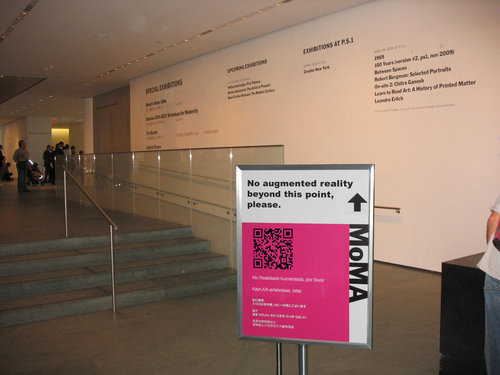This seems a very nice project: artists organize an exhibition in the New York  MoMA, and a few days before the opening the museum is “not involved yet.” How is this possible? The answer seems simple but there is quite an intellectual puzzle behind it: augmented reality.
Here is the invitation:
Opening October 9th, 4PM
Sander Veenhof and Mark Skwarek cordially invite you to their temporary exhibition in the MoMA NY, featuring augmented reality art in its proper context: a contemporary art museum.
At the same time, the ‘art invasion’ annex exhibition showcases the radical new possibilies and implications Augmented Reality is bringing to the cultural and creative field.
(PS The MoMA is not involved yet)
The artists are kind enough to explain:
Augmented Reality (AR) is the phenomenon adding virtual elements into our physical reality. These addition are viewable by pointing your contemporary smartphone to the world around you. The phone knows where you are (because of GPS) and with this data it connects to the internet to get the relevant images, visuals, 3D shapes and it puts them into your view.
‘AR’ technology allows anyone to (re-)shape anything, anywhere!
An example: the MoMA building NY will host a ‘virtual’ augmented reality show on the 9th of October 2010 But, they don’t know about it yet. The infiltration is part of the Conflux Psychogeoraphy festival.
Visitors are required to use iPhone or Android phones running the Layar Augmented Reality browser. Looking through their cameras visitors will be able to see the AR artwork. So, is this an invasion of the museum? Could the museum have any reasons to forbid this taking place, as demonstrated by a fictitious sign “no augmented reality beyond this point, please?”
Maybe you just shrug because this project seems innocent enough. But what if the AR exhibition would involve very disturbing pictures and documents? Would we still be so sure there would be no questions about a manifestation which after all is public – only the public can only see through smartphones, making the others virtually blind.
It also makes us wonder about the topic of exclusion. AR capable smartphones are not cheap (or they come with expensive data plans) – making the exhibition only accessible for the well-off, those visitors who don’t have the required tools are left wondering what the others see and discuss.
Which is okay, because it makes us wonder about the more general situation of societies with increasing inequality and what this implies in terms of access to ubiquitous knowledge and connections…


